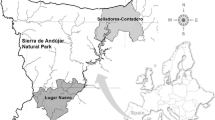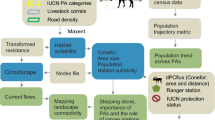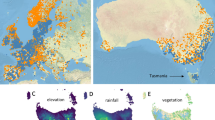Abstract
Climate change affects population cycles of several species, threatening biodiversity. However, there are few long-term studies on species with conservation issues and restricted distributions. Huemul is a deer endemic to the southern Andes in South America and it is considered endangered mostly due to a 50% reduction of its distribution over the last 500 years. To assess environmental variables potentially affecting huemul population viability and the impact of climate change, we developed population dynamics models. We used a 14-year survey data from Bernardo O’Higgins National Park, coastal Chilean Patagonia. We used Ricker models considering winter and spring temperatures and precipitation as variables influencing huemul population dynamics. We used the Bayesian information criterion (BIC) to select models with the greatest predictive power. The two best models (ΔBIC < 2) included winter temperature and density-dependence population growth drivers. The best model considered a lateral effect, where winter temperature influences carrying capacity and the second best a vertical effect with winter temperature influencing Rmax and carrying capacity. Population viability was evaluated using those models, projecting them over a 100-year period: (a) under current conditions and (b) under conditions estimated by Global Climate Models for 2050 and 2070. The extinction risk and quasi-extinction were estimated for this population considering two critical huemul abundance levels (15 and 30 individuals) for persistence. The population is currently in a quasi-extinction process, with extinction probabilities increasing with climate change. These results are crucial for conservation of species like huemul that have low densities and are threatened by climate change.




Similar content being viewed by others
References
Andrén H, Liberg O (2015) Large impact of Eurasian lynx predation on roe deer population dynamics. PLoS One 10:1–16. https://doi.org/10.1371/journal.pone.0120570
Bach LA, Pedersen RBF, Hayward M, Stagegaard J, Loeschcke V, Pertoldi C (2010) Assessing re-introductions of the African wild dog (Lycaon pictus) in the Limpopo Valley Conservancy, South Africa, using the stochastic simulation program VORTEX. J Nat Conserv 18:237–246. https://doi.org/10.1016/j.jnc.2009.09.001
Benton TG, Ranta E, Kaitala V, Beckerman AP (2001) Maternal effects and the stability of population dynamics in noisy environments. J Anim Ecol 70:590–599. https://doi.org/10.1046/j.1365-2656.2001.00527.x
Berryman A, Lima M (2007) Detecting the order of population dynamics from time series: nonlinearity causes spurious diagnosis. Ecology 88:2121–2123. https://doi.org/10.1890/06-0609.1
Berryman A, Turchin P (2001) Identifying the density-dependent structure underlying ecological time series. Oikos 92:265–270. https://doi.org/10.1034/j.1600-0706.2001.920208.x
Briceño C, Knapp LA, Silva A, Paredes J, Avendaño I, Vargas A, Sotomayor J, Vila AR (2013) Detecting an increase in an endangered huemul Hippocamelus bisulcus population following removal of cattle and cessation of poaching in coastal Patagonia, Chile. Oryx 47:273–279. https://doi.org/10.1017/S0030605312000014
Buenavista S, Palomares F (2018) The role of exotic mammals in the diet of native carnivores from South America. Mamm Rev 48:37–47. https://doi.org/10.1111/mam.12111
Carrasco JF, Casassa G, Rivera A (1998) Climatologia actual del Campo de Hielo Sur y posibles cambios por el incremento del efecto invernadero. An Inst Patagon 26:119–128
Caughley G (1994) Directions in conservation biology. J Anim Ecol 63:215–244. https://doi.org/10.2307/5542
Ciuti S, Jensen WF, Nielsen SE, Boyce MS (2015) Predicting mule deer recruitment from climate oscillations for harvest management on the northern Great Plains. J Wildl Manag 79:1226–1238. https://doi.org/10.1002/jwmg.956
Clutton-Brock TH, Coulson T (2002) Comparative ungulate dynamics: the devil is in the detail. Philos Trans R Soc B Biol Sci 357:1285–1298. https://doi.org/10.1098/rstb.2002.1128
Clutton-Brock T, Sheldon BC (2010) Individuals and populations: the role of long-term, individual-based studies of animals in ecology and evolutionary biology. Trends Ecol Evol 25:562–573. https://doi.org/10.1016/j.tree.2010.08.002
Colchero F, Medellin RA, Clark JS, Lee R, Katul GG (2009) Predicting population survival under future climate change: density dependence, drought and extraction in an insular bighorn sheep. J Anim Ecol 78:666–673. https://doi.org/10.1111/j.1365-2656.2009.01528.x
Corti P, Wittmer HU, Festa-Bianchet M (2010) Dynamics of a small population of endangered huemul deer (Hippocamelus bisulcus) in Chilean Patagonia. J Mammal 91:690–697. https://doi.org/10.1644/09-MAMM-A-047.1
Corti P, Shafer ABA, Coltman DW, Festa-Bianchet M (2011) Past bottlenecks and current population fragmentation of endangered huemul deer (Hippocamelus bisulcus): implications for preservation of genetic diversity. Conserv Genet 12:119–128. https://doi.org/10.1007/s10592-009-9997-7
Dee DP, Uppala SM, Simmons AJ, Berrisford P, Poli P, Kobayashi S, Andrae U, Balmaseda MA, Balsamo G, Bauer P, Bechtold P, ACM B, van de Berg L, Bidlot J, Bormann N, Delsol C, Dragani R, Fuentes M, Geer AJ, Haimberger L, Healy SB, Hersbach H, Hólm EV, Isaksen L, Kållberg P, Köhler M, Matricardi M, AP MN, Monge-Sanz BM, Morcrette J-J, Park B-K, Peubey C, de Rosnay P, Tavolato C, Thépaut JN, Vitart F (2011) The ERA-Interim reanalysis: configuration and performance of the data assimilation system. Q J R Meteorol Soc 137:553–597. https://doi.org/10.1002/qj.828
ECFM-RW (2012) ERA-Interim project, single parameter 6-hourly surface analysis and surface forecast time series. https://doi.org/10.5065/D64747WN
Elbroch LM, Wittmer HU (2013) The effects of puma prey selection and specialization on less abundant prey in Patagonia. J Mammal 94:259–268. https://doi.org/10.1644/12-MAMM-A-041.1
Frid A (2001) Habitat use by endangered huemul (Hippocamelus bisulcus): cattle, snow, and the problem of multiple causes. Biol Conserv 100:261–267. https://doi.org/10.1016/S0006-3207(01)00064-7
Gaillard JM, Mark Hewison AJ, Klein F, Plard F, Douhard M, Davison R, Bonenfant C (2013) How does climate change influence demographic processes of widespread species? Lessons from the comparative analysis of contrasted populations of roe deer. Ecol Lett 16:48–57. https://doi.org/10.1111/ele.12059
Galende GI, Raffaele E (2016) Predator feeding ecology on Patagonian rocky outcrops: implications for colonies of mountain vizcacha (Lagidium viscacia). Stud Neotrop Fauna Environ 51:1–8. https://doi.org/10.1080/01650521.2016.1185270
Ginzburg LR, Slobodkin LB, Johnson K, Bindman AG (1982) Quasiextinction probabilities as a measure of impact on population growth. Risk Anal 2:171–181. https://doi.org/10.1111/j.1539-6924.1982.tb01379.x
González-Suárez M, Revilla E (2013) Variability in life-history and ecological traits is a buffer against extinction in mammals. Ecol Lett 16:242–251. https://doi.org/10.1111/ele.12035
Hansen BB, Aanes R, Herfindal I, Kohler J, Sæther BE (2011) Climate, icing, and wild arctic reindeer: past relationships and future prospects. Ecology 92:1917–1923. https://doi.org/10.1890/11-0095.1
Hijmans RJ, Cameron SE, Parra JL, Jones PG, Jarvis A (2005) Very high resolution interpolated climate surfaces for global land areas. Int J Climatol 25:1965–1978. https://doi.org/10.1002/joc.1276
Inchausti P, Ginzburg LR (2009) Maternal effects mechanism of population cycling: a formidable competitor to the traditional predator-prey view. Philos Trans R Soc B Biol Sci 364:1117–1124. https://doi.org/10.1098/rstb.2008.0292
IUCN (2016) Hippocamelus bisulcus. In: IUCN red list of threatened species. Version 2016. http://www.iucnredlist.org/details/10054/0. Accessed 22 Nov 2016
Jacobson AR, Provenzale A, von Hardenberg A, Bassano B, Festa-Bianchet M (2004) Climate forcing and density dependence in a mountain ungulate population. Ecology 85:1598–1610. https://doi.org/10.1890/02-0753
Johnsen K, Boonstra R, Boutin S, Devineau O, Krebs CJ, Andreassen HP (2016) Surviving winter: food, but not habitat structure, prevents crashes in cyclic vole populations. Ecol Evol 7:115–124. https://doi.org/10.1002/ece3.2635
Kohlmann SG, Schmidt GA, Garcelon DK (2005) A population viability analysis for the island fox on Santa Catalina Island, California. Ecol Model 183:77–94. https://doi.org/10.1016/j.ecolmodel.2004.07.022
Koons D, Colchero F, Hersey K, Gimenez O (2015) Disentangling the effects of climate, density dependence, and harvest on an iconic large herbivore’s population dynamics. Ecol Appl 25:956–967. https://doi.org/10.1890/14-0932.1
Lee AM, Saether B-E, Engen S (2011) Demographic stochasticity, allee effects, and extinction: the influence of mating system and sex ratio. Am Nat 177:301–313. https://doi.org/10.1086/658344
Mace GM, Collar NJ, Gaston KJ, Hilton-Taylor C, Akçakaya HR, Leader-Williams N, Milner-Gulland EJ, Stuart SN (2008) Quantification of extinction risk: IUCN’s system for classifying threatened species. Conserv Biol 22:1424–1442. https://doi.org/10.1111/j.1523-1739.2008.01044.x
Marín JC, Varas V, Vila AR, López R, Orozco-terWengel P, Corti P (2013) Refugia in Patagonian fjords and the eastern Andes during the last glacial maximum revealed by huemul (Hippocamelus bisulcus) phylogeographical patterns and genetic diversity. J Biogeogr 40:2285–2298. https://doi.org/10.1111/jbi.12161
Martay B, Brewer MJ, Elston DA, Bell JR, Harrington R, Brereton TM, Barlow KE, Botham MS, Pearce-Higgins JW (2017) Impacts of climate change on national biodiversity population trends. Ecography (Cop) 40:1139–1151. https://doi.org/10.1111/ecog.02411
Moss RH, Edmonds JA, Hibbard KA, Manning MR, Rose SK, van Vuuren DP, Carter TR, Emori S, Kainuma M, Kram T, Meehl GA, Mitchell JFB, Nakicenovic N, Riahi K, Smith SJ, Stouffer RJ, Thomson AM, Weyant JP, Wilbanks TJ (2010) The next generation of scenarios for climate change research and assessment. Nature 463:747–756. https://doi.org/10.1038/nature08823
Moyes K, Nussey DH, Clements MN, Guinness FE, Morris A, Morris S, Pemberton JM, Kruuk LEB, Clutton-Brock TH (2011) Advancing breeding phenology in response to environmental change in a wild red deer population. Glob Chang Biol 17:2455–2469. https://doi.org/10.1111/j.1365-2486.2010.02382.x
Nevoux M, Gimenez O, Arlt D, Nicoll M, Jones C, Norris K (2011) Population regulation of territorial species: both site dependence and interference mechanisms matter. Proc Biol Sci 278:2173–2181. https://doi.org/10.1098/rspb.2010.2352
Ohlberger J, Rogers LA, Stenseth NC (2014) Stochasticity and determinism: how density-independent and density-dependent processes affect population variability. PLoS One 9:1–9. https://doi.org/10.1371/journal.pone.0098940
Pantoja S, Iriarte J, Daneri G (2011) Oceanography of the Chilean Patagonia. Cont Shelf Res 31:149–153. https://doi.org/10.1016/j.csr.2010.10.013
Pérez-Barbería FJ, Hooper RJ, Gordon IJ (2013) Long-term density-dependent changes in habitat selection in red deer (Cervus elaphus). Oecologia 173:837–847. https://doi.org/10.1007/s00442-013-2686-8
Plard F, Gaillard JM, Coulson T, Hewison AM, Delorme D, Warnant C, Bonenfant C (2014) Mismatch between birth date and vegetation phenology slows the demography of roe deer. PLoS Biol 12:1–8. https://doi.org/10.1371/journal.pbio.1001828
Post E, Forchhammer MC (2008) Climate change reduces reproductive success of an Arctic herbivore through trophic mismatch. Philos Trans R Soc B Biol Sci 363:2367–2373. https://doi.org/10.1098/rstb.2007.2207
QGIS Development Team (2020). QGIS geographic information system. Open Source Geospatial Foundation Project. http://qgis.osgeo.org
R Core Development Team (2016) R: A language and environment for statistical computing. http://www.Rproject.org
Raftery AE, Zimmer A, Frierson DMW, Startz R, Liu P (2017) Less than 2 °C warming by 2100 unlikely. Nat Clim Chang 7:637–641. https://doi.org/10.1038/nclimate3352
Ríos-Saldaña CA, Delibes-Mateos M, Ferreira CC (2018) Are fieldwork studies being relegated to second place in conservation science? Glob Ecol Conserv 14:e00389. https://doi.org/10.1016/j.gecco.2018.e00389
Riquelme C, Estay SA, López R, Pastore H, Soto-Gamboa M, Corti P (2018) Protected areas’ effectiveness under climate change: a latitudinal distribution projection of an endangered mountain ungulate along the Andes Range. PeerJ 6:e5222. https://doi.org/10.7717/peerj.5222
Royama T (1992) Analytical population dynamics. Chapman and Hall, London
Schwarz G (1978) Estimating the dimension of a model. Ann Stat 6:461–464. https://doi.org/10.1214/aos/1176344136
Shaw AK, Galaz JL, Marquet PA (2012) Population dynamics of the vicuña (Vicugna vicugna): density-dependence, rainfall, and spatial distribution. J Mammal 93:658–666. https://doi.org/10.1644/11-MAMM-A-257.1
Simmonds EG, Coulson T (2015) Analysis of phenotypic change in relation to climatic drivers in a population of Soay sheep Ovis aries. Oikos 124:543–552. https://doi.org/10.1111/oik.01727
Solberg EJ, Jordhøy P, Strand O, Aanes R, Loison A, Saether B-E, Linnell JDC (2001) Effects of density-dependence and climate on the dynamics of a Svalbard reindeer population. Ecography (Cop) 24:441–451. https://doi.org/10.1111/j.1600-0587.2001.tb00479.x
Stocker TF, Qin D, Plattner G et al (2014) Climate change 2013 - the physical science basis. Cambridge University Press, Cambridge
Taig-Johnston M, Strom MK, Calhoun K, Nowak K, Ebensperger LA, Hayes L (2017) The ecological value of long-term studies of birds and mammals in Central America, South America and Antarctica. Rev Chil Hist Nat 90:7. https://doi.org/10.1186/s40693-017-0070-5
Taylor RA, White A, Sherratt JA (2013) How do variations in seasonality affect population cycles? Proc R Soc B Biol Sci 280:20122714–20122714. https://doi.org/10.1098/rspb.2012.2714
Tveraa T, Stien A, Bårdsen B-J, Fauchald P, Bohrer G (2013) Population densities, vegetation green-up, and plant productivity: impacts on reproductive success and juvenile body mass in reindeer. PLoS One 8:e56450. https://doi.org/10.1371/journal.pone.0056450
van Manen FT, Haroldson MA, Bjornlie DD, Ebinger MR, Thompson DJ, Costello CM, White GC (2016) Density dependence, whitebark pine, and vital rates of grizzly bears. J Wildl Manag 80:300–313. https://doi.org/10.1002/jwmg.1005
Vindenes Y, Engen S (2017) Demographic stochasticity and temporal autocorrelation in the dynamics of structured populations. Oikos 126:462–471. https://doi.org/10.1111/oik.03958
Wang G, Hobbs NT, Twombly S, Boone RB, Illius AW, Gordon IJ, Gross JE (2009) Density dependence in northern ungulates: interactions with predation and resources. Popul Ecol 51:123–132. https://doi.org/10.1007/s10144-008-0095-3
White KS, Gregovich DP, Levi T (2017) Projecting the future of an Alpine ungulate under climate change scenarios. Glob Chang Biol 38:42–49. https://doi.org/10.1111/gcb.13919
Willi Y, Van Buskirk J, Hoffmann AA (2006) Limits to the adaptive potential of small populations. Annu Rev Ecol Evol Syst 37:433–458. https://doi.org/10.1146/annurev.ecolsys.37.091305.110145
Williams CM, Henry HAL, Sinclair BJ (2015) Cold truths: how winter drives responses of terrestrial organisms to climate change. Biol Rev 90:214–235. https://doi.org/10.1111/brv.12105
Zubillaga M, Skewes O, Soto N, Rabinovich JE, Colchero F (2014) Bayesian inference on the effect of density dependence and weather on a guanaco population from Chile. PLoS One 9:e115307. https://doi.org/10.1371/journal.pone.0115307
Acknowledgments
We are grateful to Chile National Forestry Service at Magallanes District (CONAF) for collaborating in this research, providing historical data, and for their ongoing commitment to huemul conservation. Especial thanks to park wardens of Bernardo O’Higgins National Park and to J. Cusack and anonymous reviewers for comments on the manuscript.
Funding
This work was supported by CONAF Magallanes District. C. Riquelme and P. Corti were funded by CONICYT-PAI [7910012016] and FONDECYT [3110187], both granted to P. Corti. S.A. Estay was funded by CAPES-CONICYT [FB-002 (line 4)] and FONDECYT [1160370].
Author information
Authors and Affiliations
Contributions
CR, SE, and PC were equally involved in designing the study, performing statistical analyses, and writing the manuscript. RC performed fieldwork and data gathering. All authors were involved in manuscript writing.
Corresponding author
Ethics declarations
Conflict of interest
The authors declare that they have no conflict of interest.
Ethical approval
All applicable institutional and/or national guidelines for the care and use of animals were followed.
Additional information
Publisher’s note
Springer Nature remains neutral with regard to jurisdictional claims in published maps and institutional affiliations.
Rights and permissions
About this article
Cite this article
Riquelme, C., Estay, S.A., Contreras, R. et al. Extinction risk assessment of a Patagonian ungulate using population dynamics models under climate change scenarios. Int J Biometeorol 64, 1847–1855 (2020). https://doi.org/10.1007/s00484-020-01971-4
Received:
Revised:
Accepted:
Published:
Issue Date:
DOI: https://doi.org/10.1007/s00484-020-01971-4




